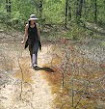Later at home, ID'ing the day's photos, I discovered it was a Bird's-Foot violet.
The flower itself looks like a common violet, but look at its leaves: they're shaped like, you guessed it, a bird's foot.
Viola pedata L.
I had never even of it.
But this is a very rare sight.
In
You can't be suspicious of a tree, or accuse a bird or a squirrel of subversion or challenge the ideology of a violet. -Hal Borland
Anyone who wants to can look up exactly where to find it - and this site has the links to the resources to do it- but they'll have to do a little homework, and maybe just as well they should, because I know I became more invested and respectful through that process myself. That's why I'm not posting a map right here. & I have to say, I believe we're all lucky that most people would not only dismiss this violet, but mistake the landscape where it lives as any side-of-a-county-road. I drove right past it for years.
Yes, there was a time in my life before-the-plants.
Acclaimed poet and novelist Elizabeth Smart tells how gardening madness struck her suddenly in 1967 "like a cold or an unsuitable love affair." - Alice Van Wart
Bird's-Foot Violet's status was changed from
It has some extraordinary protection:
Province Ontario Endangered Species Act
R.S.O. 1990, Chapter E.15
As of January 2006, there were only 43 species listed in regulation under the ESA.
This Bird's-Foot Violet is one of them.
*
"To believe that you do not live a political life is to lie to yourself about your life." Robin Matthews, poet.
And so, that is why I actually have to clearly state this here at least once:
DO NOT WILD-COLLECT NATIVE PLANTS.
Besides, like most of our natives, as rare as they might be in the wild, ethical seed-propagated Bird's-Foot Violets are easy to source & purchase at many nurseries, for less than $6 each -- far less expensive than $50,000, 2 years imprisonment and the consequences of its and its landscape's extinction in the wild.
“And everybody hates a tourist.”Even themselves.
"Life, which is sometimes difficult, a struggle for significance and self-respect, and you know, for righteous employment, to be doing the right thing.”
It wasn't an easy decision. I finally decided to settle this blog here nevetherless.
Why?
I believe that accessible resources and education can lead to meaningful experiences, work, progress and citizenship in eco-restoration and native plant ecology. I don't believe this education should be exclusive to people who meet academic acceptance requirements and can afford the cost and time to go back to full-time post-secondary studies.
I believe that we need to keep our common values and interests, well, in our commons. We need to share knowledge. We need to guide and inspire each other and let other people know they are not condemned to be mystified about how to take care of their own land. (BTW: I don't believe that this ideology will cut into folks' opportunities to make a living -- I can't see Toronto soon running out of people-with-$ but short-on-time, who are willing to pay ecologically aware responsible folks to design, landscape & look after their yards, cottage properties, commercial landscapes and public spaces).
We need to teach each other literacy about our natural heritage and how to be meaningfully involved in our natural common spaces.
Fortunately, there are many stewardship & volunteer opportunities which, while doing practical work, also allow us to learn & share knowledge - & I'll be posting them here.
We also need affordable accessible localized public grassroots resources & workshops. For me, LEAF's Tree Tenders workshop is a model example. We also need more open-learning courses like these and this one too, unfortunately they're not offered every year & while $500 is a comparatively good deal for a course in this province, it's more than some folks can afford.
And, we need to know where to look for what we are trying to approximate, and then to be literate with what we find. We need to visit the symphonies of what's left of our region's brilliant complex ecology: authentic natural areas, remnants and the most common & the very rarest native plant communities and associations. These are our richest and ultimate references, and they inspire, direct and fuel us. Without access to them we can not aspire to or comprehend what it is we are trying to protect, steward, conserve, recreate or restore.
Data Sources: Canadian Wildlife Service, 2004 & COSEWIC Status Report.



No comments:
Post a Comment